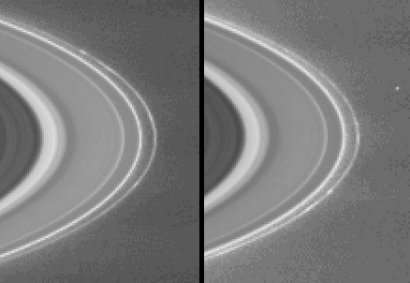Saturn’s rings clumps Credit: NASA/JPL/Space Science Institute
A Skoltech-led team of international scientists has developed a mathematical model that makes sense of one of the great mysteries of Saturn's rings.
The rings of Saturn are formations of dust and ice that swirl along Saturn's equatorial plane. They were first spotted in 1610 by Galileo Galilei. At the time, he figured they were part of the planet itself. In-depth study of these unique formations only became possible in the 20th century in the era of space exploration. And many mysteries related to their formation and processes remain unanswered.
Most of the planets in the solar system have remain unchanged for millions of years, but Saturn's rings exhibit extreme instability. This is particularly true of the F-ring, one of its outermost rings. The F-ring has been known to change over the course of days or even hours. For example, spacecraft have detected clumps of matter in the F-ring that suddenly disappear.
While it is not yet known what causes this erratic behavior, it is known that the processes of particle aggregation (fusion) and fragmentation (decay) play a role. In planetary rings, such as those of Saturn, these processes occur on a particularly large scale, necessitating a consistent balance between fragmentation and aggregation.
Scientists from universities in Russia (Skoltech, Moscow State University, the Institute of Numerical Mathematics of the Russian Academy of Sciences), the United Kingdom (the University of Leicester), and the United States (Boston University) teamed up to shed light on the mysterious F-ring using a mathematical model that had previously been used to study Saturn's more stable elements.
Using the model, the Skoltech-led team demonstrated the possibility of ceaseless periodic oscillatory regimes for particle fusion and fragmentation within Saturn's rings. In other words, they have identified a mechanism that could cause the formation of clots in a planetary ring such as the F-ring. Their findings satisfy the law of mass conservation, which holds that mass cannot be created or destroyed in chemical reactions.
The results of the study have been published is the scientific journal Physical Review Letters.
"We spent nearly three years working on this before presenting our results for publication. This is because it took us a great deal of time to work through our doubts and the validation stages. In the end, we found an example of a never-ending periodic oscillatory solution from the mathematical model of the aggregation and fragmentation processes of Saturn's rings. Furthermore, we determined that these periodic regimes lead to a stable limiting cycle, which is very surprising for a model under the mass-conservation law, where stable equilibrium solutions are expected to be found. As our main results come from numerical simulations, we hope to attract interest from the mathematical community for the elaboration of rigorous analytical proofs of the presented phenomena. Anyway, we infer that those results may shed some new light on the phenomena of periodic clumps arising in the F-ring of Saturn," said lead author and Skoltech research scientist Sergey Matvee
More information: S. A. Matveev et al, Oscillations in Aggregation-Shattering Processes, Physical Review Letters (2018). DOI: 10.1103/PhysRevLett.119.260601
Journal information: Physical Review Letters
Provided by Skolkovo Institute of Science and Technology
























